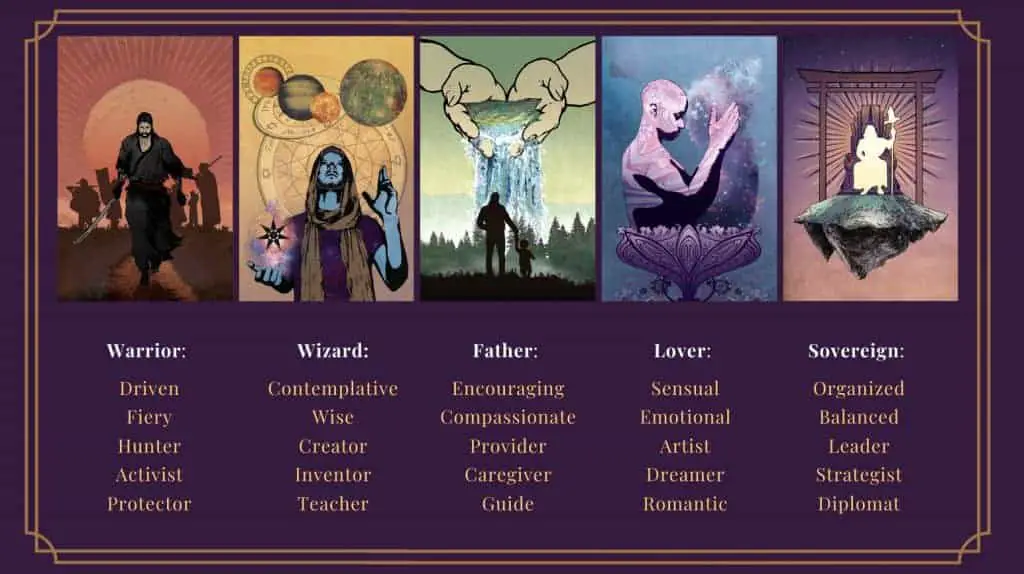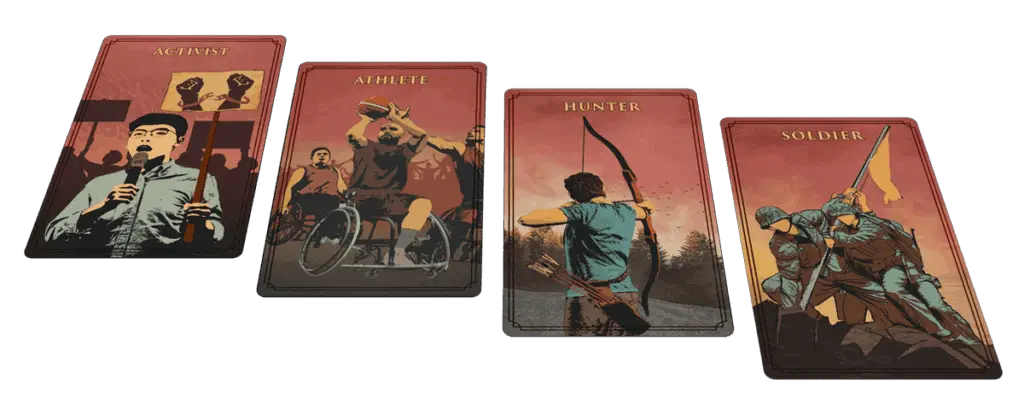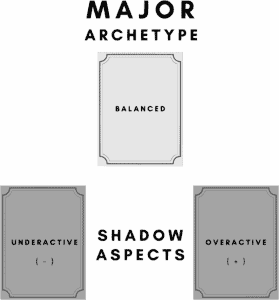Stay in Touch
Join the HeroRise Newsletter to learn about Masculine Archetypes and connect.
You can also use this deck for divination, similar to the tarot, or as a reference for contemplation. By reflecting on the cards, you can uncover your unconscious patterns and behaviors. Helping you find your balanced potential.
This deck can help anyone connect with the Masculine Archetypes – regardless of biology, gender identity, or sexual orientation. I believe that we all have access to a wide range of Masculine expressions. This work is inclusive to everyone. All humans. All people.
I wrote this guidebook from my perspective as a man. Throughout, I use “he/him” pronouns when referencing the Archetypes. If you identify with a different pronoun, feel free to exchange “he/him” with your own.
This work is for anyone interested in exploring Masculinity on a personal level. How you come to this can be as rich and complex as Masculinity itself.
What if I told you that everyone had the same underlying set of behaviors and ideas. So deeply rooted in our make up that it affected every aspect of your life? This is the theory that made Carl Jung so revolutionary as a psychologist. Jung believed that “there exists a second psychic system of a collective, universal and impersonal nature that is identical in all individuals.” (The Archetypes and the Collective Unconscious, p. 43). Patterns repeat in myths, movies, and even yourselves.
When imagining a Warrior, what comes to mind? You might picture them as courageous, disciplined, and decisive. You might not know where you got the impression but can easily conjure up the characteristics of a Warrior in your mind. Myths, movies, and cultural narratives reinforce these ideas. The qualities of a Warrior can seem so familiar because they are a part of our Collective Unconscious.
Archetypes are a part of the collective unconscious and serve to organize, direct, and inform human thought and behavior. They are a collection of universal patterns that humans developed over thousands of years of evolution.
I have found Archetypes allow me to access underlying patterns of my Psyche. For instance, working with the Father Archetype gave me symbols and ideas that led to me healing my wounds around my father, abandonment, and authority. My father was so busy with work and emotionally distant during my childhood. That instilled a model of behavior for me around the Father Archetype.
I repeated some of these patterns by running away from responsibility. I was obsessed with being completely self-sufficient and took pride in being a lone wolf. I wasn’t open emotionally and made people feel uncared for and abandoned. By working with the Father Archetype, I could see and change my pattern of behavior. Through meditation, therapy, and contemplation, I saw what traumas I was repeating from my past.
An important realization I had is that my father wasn’t the Father Archetype. The Archetypal pattern was about how I nurtured and created emotional safety for others. My father played a big part in modeling behaviors, but it was more profound than that. This was so closely tied to my ego, world view, and affected every aspect of my life.
As I connected to the Father Archetype, I dedicated myself to building a community, reaching out to friends, and becoming someone people could rely on. This allowed me to become a stabilizing force for those I love. It not only improved my relationships, but it made me feel more rooted in my Masculinity. I realized how I could heal our cultural wounds around the Father Archetype through my actions.
Each Archetype allows you to examine a different facet of yourself. Giving you a focus that can help you embody a more mature, healthy, and balanced in your Masculinity. Carl Jung said, “It is only possible to live the fullest life when we are in harmony with these symbols; wisdom is a return to them.” (Collected Works of CG Jung 8:794).
The HeroRise Masculine Archetype Deck explores the Five Major Archetypes of Warrior, Wizard, Father, Lover, and Sovereign.
The five Major Archetypes within the HeroRise system are; Warrior, Wizard, Father, Lover, and Sovereign. The Archetypes represent different psychological patterns you use to make up your identity. Creating a conscious relationship with the various Archetypes can help you embody mature and balanced Masculinity.

There are many nuances to each of the Major Archetypes. That is why I created four Sub-Archetypes for each of the Major Archetypes. For instance, the Warrior has the Sub-Archetypes of Activist, Athlete, Hunter, and Soldier.
The Sub-Archetypes can explore the expressions of the Major Archetype with more detail and granularity.

“The shadow is a moral problem that challenges the whole ego-personality, for no one can become conscious of the shadow without considerable moral effort. To become conscious of it involves recognizing the dark aspects of the personality as present and real. This act is the essential condition for any kind of self-knowledge.”
— Carl Jung, Aion (1951)
Each of the Five Major Archetypes has two Shadow Aspects (Overactive and Underactive). The Shadow is the repressed aspects of your identity. They can be behaviors you have learned as coping mechanisms or reactions to past trauma. If you do not consciously seek balance with an Archetype, you can begin to be ruled by the bipolar Shadow Aspects.
One of the Archetypes I struggle to keep in balance is the Lover. The two Shadow Aspects are the Addict (+) and the Lost Dreamer (-). I moved around a lot as a kid. It was tough to make a friend and lose them so quickly. I became emotionally detached as a coping mechanism. I found refuge in my imagination, knowing it would be with me no matter where I lived. As an adult, I still find myself lost in daydreams to cope with loneliness. I often fall into the trappings of the Lost Dreamer.
I have realized that to find more balance, I need to be excited by my desires. I gain a lot by expressing and seeking after the thrills of life. If I let myself become a total hedonist, I fall into the Shadow Aspect of the Addict. I find it’s best when I don’t push away the Shadow Aspects of my psyche. I try and find moderation between them to allow me to experience the Lover Archetype’s full potential. By making these changes, my life has become more emotionally rich and vibrant.
Working with the Shadow Aspects will give you a deeper understanding of your internal process and patterns. Allowing you to grow beyond past wounds.

A good story shakes you to the core. I can remember the first time I watched the original Star Wars as a kid. I felt I could take over the world. The next day I joined a lacrosse team at school, something I would never have seen myself doing. Still, I felt inspired by the story of Luke overcoming the dark forces of the universe. Stories can change how you perceive the world and help us create meaning to events in our life.
You can utilize the power of stories as a transformational tool. The key is to take control of the narrative. Stories can be interacted with in two ways, as the active storyteller or the passive listener. As the storyteller, you can mold the meaning behind events, make small moments seem triumphant, and reinstill that feeling of inspiration from overcoming the odds.
For the longest time, I thought I wasn’t a strong person. It was because I was told repeatedly how skinny and weak I was as a teenager. For years I worked out and still didn’t feel strong. I realized I was always telling myself the story I heard when I was a kid. I took control of the narrative and told myself I was strong every time I worked out. Eventually my identity changed when I no longer saw myself as that skinny weak child. I not only changed my identity, but I also saw massive improvements in my workouts. By changing the story, I changed who I was.
Your identity is the culmination of the stories you tell yourself, but they aren’t fixed points. You have control over the narrative. The Hero’s Journey is a tool that can help you re-write the stories and help you become the hero of your tale.
Joseph Campbell coined the term “Hero’s Journey.” His studies in narrative and comparative mythology found that every story had the same series of events. He called it the monomyth, or the Hero’s Journey. In the tale, the Hero leaves the ordinary, overcomes a great conflict, and returns home changes. Joseph Campbell created the twelve stages to the Hero’s Journey to give a detailed map of the process of transformation.
Working with the Hero’s Journey unlocks the power of story. You can use it to change the stories of your past or write new ones about your future. The HeroRise Masculine Archetype Deck comes with twelve cards based off of the Hero’s Journey. Become the active storyteller of your life.
Our daily lives are much more complicated than stories. It’s hard to pinpoint beginnings and ends. When looking at the Hero’s Journey every day, remember that we are usually in multiple stages of the journey at any given time.
I hardly ever have only one project at a time. Even as I write this, I have a painting I am working on, an upcoming test for boxing, and spending time healing interpersonal problems with family and friends. The Hero’s Journey is a never-ending exploration, and different quests have different timelines that can overlap.
And, to be real, life isn’t always a fascinating epic. The drive for an exceptional adventure has been used by marketing campaigns to pressure us into a consumptive culture. Try not to get unconsciously swept away into the need to be a flashing Instagrammer just to be happy. There are other ways to find peace and growth in your life.
Join the HeroRise Newsletter to learn about Masculine Archetypes and connect.
All right reserved by HeroRise © 2020
Read Terms and Conditions
Refund and Return Policy